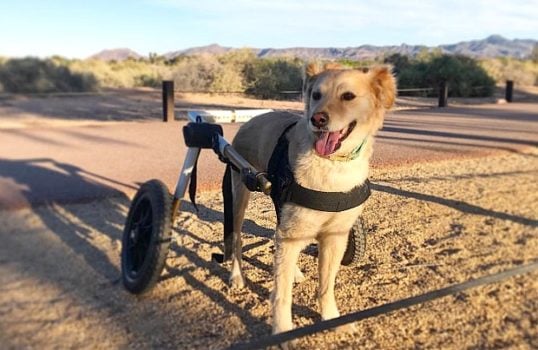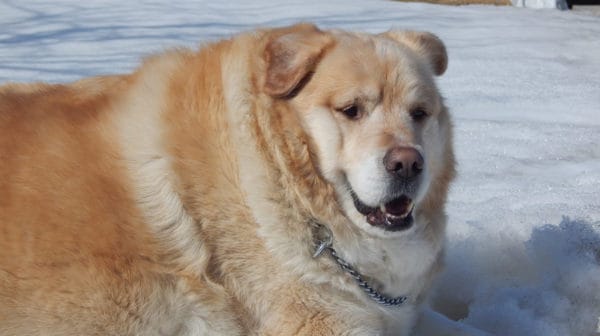Scooty has come a long way in her six years of living, from a timid Mexican dog who couldn’t walk to a happy San Diego gal with over 40,000 Instagram followers. She might need a wheelchair sometimes, but she has never let her disabilities slow her down – a clear reminder that even the biggest challenges can turn into good fortune if you work hard and stay positive.
A Harrowing Beginning
Scooty’s story started miles away in November 2011 when she was found in Mexico by Baja Dog Rescue. She had been hit by a car and left behind on the side of the road. Although little is known about her past, her rescuers believe she was born and raised on the streets. Fortunately, a local dog lover and volunteer with the Baja Dog Rescue spotted Scooty after the accident and alerted the rescue.
“Scooty was found with a broken back in a few places, broken tail, broken ribs, crushed hips and a spinal cord injury,” says Erica Loring, Scooty’s owner. “She had large, open wounds on her back and front elbows [and her skin was scraped] to her bones on her back legs. She was badly infected and her back left leg had maggots in it.”
By the time Scooty made it to the shelter, things didn’t look good. Because of the extent of her wounds and the limited funds the shelter had, they did their best to clean and treat her open wounds and treated her with heavy antibiotics.
“I don’t know if she was a candidate for surgery or not, but she did not undergo any,” says Loring. “They made her a wheelchair out of PVC pipes, but she didn’t use it well and she required pretty constant, round the clock care.”
Searching for a Home
Finding a family for Scooty proved to be a challenge. She waited at the shelter from November until February 2012 for somebody to take her, but nobody seemed ready to take on the challenge of a dog who couldn’t walk. The shelter certainly tried, doing e-mail blasts for help and publishing stories on their website and Facebook page about her. At the end of February, Loring found out about Scooty.
“I found [her] by chance, when they were looking for more funds to help support her round-the-clock care, wheelchair and therapy,” says Loring. “I fell in love with her picture before I read about her condition.”

Loring wrote to the shelter immediately, trying to convince them she was ready and willing to adopt Scooty and give her the medical help and the love she needed. Despite initial concerns, the rescue finally agreed it was a good match.
“After I convinced them I would take on all responsibility regardless, they actually brought her to San Diego,” says Loring. “The founder of the rescue had a home right around the corner from me!”
The Road to Recovery
Despite having received treatment for several months at the rescue, Scooty wasn’t completely healed by the time she arrived in the U.S.
“She still had open wounds and was on continuous antibiotics, couldn’t walk and had no control over [her bladder],” says Loring. “The vets essentially gave me no hope for any sort of recovery; they said she would have improved by now if she ever would.”
While that wasn’t what Loring wanted to hear, she was okay with the diagnosis and wanted to give Scooty the best possible life – but she also wanted to try more.
“Besides being on a few medications and taking X-rays, the doctors didn’t think surgery was a good option,” says Loring. “So we started her on laser treatments and acupuncture for the wounds and nerves.”
Within three months of the new treatments, Scooty started to stand for a few seconds and, within six months, she could take tentative steps without a wheelchair.

“It was very fractured walking with a lot of help, wobbling and falling with a mix of scooting,” says Loring. “We started her with physical therapy to help with coordination, and eventually she started walking more and more and even running [without her wheelchair]!”
In addition to her physical recovery, Scooty also had emotional issues to deal with. “She would go nuts at the sight of people at first, but she is such a well-mannered and smart dog, she learned fast to not bark and to behave in public,” Loring says. “She was brilliant and learned everything we wanted almost immediately.”
Today, Scooty’s progress is far beyond what anybody could have wished for her. She uses her wheelchair only for long walks, hikes and running.
“She has the sweetest disposition, is so well behaved and goofy, and makes us laugh every day. I couldn’t ask for a more perfect dog; she may require a little different attention than other dogs, but it’s worth it,” Loring says.
Scooty still has days when her nerves act up and she needs to use the chair or a harness, but Loring says it isn’t often and that acupuncture and laser therapy help. As her legs have healed, Scooty’s personality has also blossomed.
“It’s incredible to hear how Scooty affects so many people, we get the most heart warming messages in social media,” Loring says. In addition to helping re-home two paralyzed dogs to Scooty’s followers, Loring says she hears stories every day about the ways Scooty impacts the world.
“There is a young man who has suffered from depression and he tells us how much of a [positive] effect Scooty can have on his day. There is a mother who has a special needs child [and] she shares Scooty before bed, especially after a hard day,” she says. “Scooty serves as an example that different is not less and to never give up. Being different makes you unique and it’s how you see the world.”
Images via: @super_scooty

Diana Bocco is a full-time writer and adventurer, whose work has been published in DiscoveryChannel.com, Yahoo!, & Popular Mechanics.
Share:









